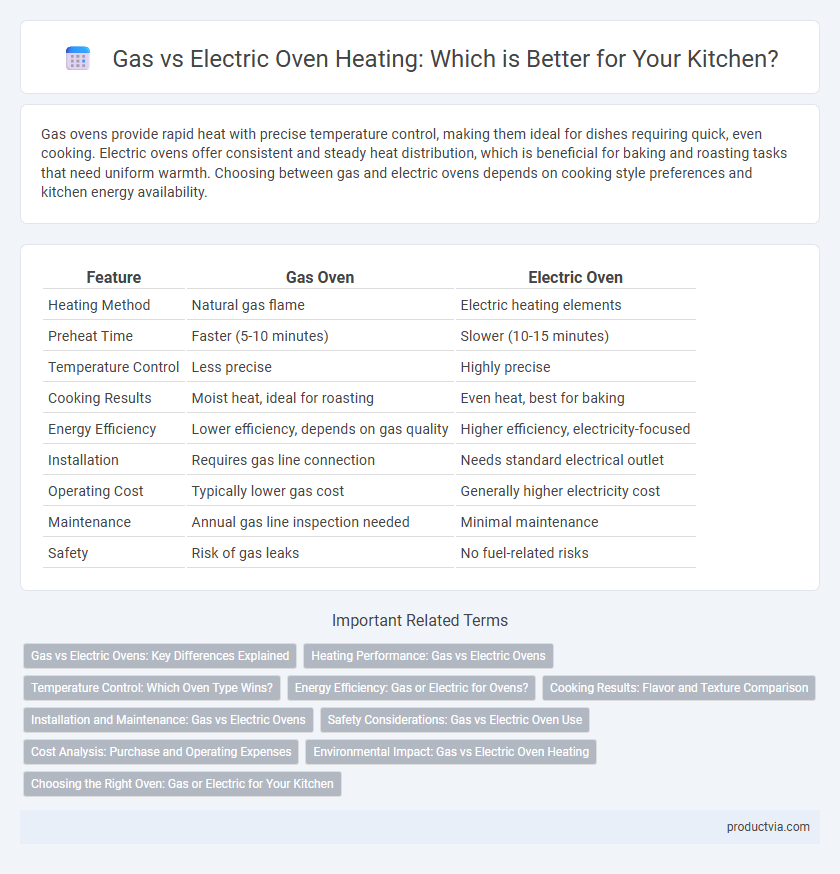Gas ovens provide rapid heat with precise temperature control, making them ideal for dishes requiring quick, even cooking. Electric ovens offer consistent and steady heat distribution, which is beneficial for baking and roasting tasks that need uniform warmth. Choosing between gas and electric ovens depends on cooking style preferences and kitchen energy availability.
Table of Comparison
| Feature | Gas Oven | Electric Oven |
|---|---|---|
| Heating Method | Natural gas flame | Electric heating elements |
| Preheat Time | Faster (5-10 minutes) | Slower (10-15 minutes) |
| Temperature Control | Less precise | Highly precise |
| Cooking Results | Moist heat, ideal for roasting | Even heat, best for baking |
| Energy Efficiency | Lower efficiency, depends on gas quality | Higher efficiency, electricity-focused |
| Installation | Requires gas line connection | Needs standard electrical outlet |
| Operating Cost | Typically lower gas cost | Generally higher electricity cost |
| Maintenance | Annual gas line inspection needed | Minimal maintenance |
| Safety | Risk of gas leaks | No fuel-related risks |
Gas vs Electric Ovens: Key Differences Explained
Gas ovens provide instant heat and more precise temperature control through flame adjustment, making them ideal for roasting and broiling. Electric ovens maintain more even heat distribution due to electric heating elements, resulting in consistent baking performance and better temperature stability. Energy efficiency varies by usage; gas ovens typically cost less to operate, while electric ovens offer cleaner operation and easier installation.
Heating Performance: Gas vs Electric Ovens
Gas ovens provide rapid heat-up times and moisture retention, making them ideal for roasting and baking with consistent browning. Electric ovens offer precise temperature control and even heat distribution due to their element design, enhancing baking accuracy and stability. Performance differences impact cooking outcomes, with gas excelling in quick heating and electric preferred for delicate baking tasks.
Temperature Control: Which Oven Type Wins?
Gas ovens offer rapid temperature changes and intuitive heat control through manual knobs, making them ideal for precision cooking that demands quick adjustments. Electric ovens provide more consistent and even heat distribution with advanced digital controls, resulting in precise temperature maintenance and less fluctuation. For exact temperature control, electric ovens generally surpass gas models, especially in baking and roasting tasks.
Energy Efficiency: Gas or Electric for Ovens?
Gas ovens typically offer faster preheating times and lower operating costs due to natural gas being cheaper than electricity, enhancing energy efficiency. Electric ovens provide more even and consistent heat distribution, which can improve cooking precision and reduce energy waste. Choosing between gas and electric depends on the balance between energy cost, cooking performance, and household energy sources.
Cooking Results: Flavor and Texture Comparison
Gas ovens provide a moist cooking environment that helps retain the natural flavors and juiciness of dishes, enhancing taste and producing tender textures. Electric ovens deliver consistent and even heat distribution, resulting in precise browning and crispier finishes ideal for baked goods. Choosing between gas and electric ovens significantly impacts the flavor profile and texture quality of cooked meals.
Installation and Maintenance: Gas vs Electric Ovens
Gas ovens typically require professional installation due to the need for precise gas line connections, ensuring safety and efficiency, while electric ovens generally have simpler plug-and-play installation, often compatible with existing electrical outlets. Maintenance for gas ovens involves regular inspection of gas lines and burners to prevent leaks and ensure proper combustion, whereas electric ovens demand routine checks of heating elements and electrical components to maintain optimal performance. Choosing between gas and electric ovens depends on the availability of gas lines, electrical capacity, and willingness to manage the specific maintenance needs of each type.
Safety Considerations: Gas vs Electric Oven Use
Gas ovens pose risks of gas leaks and carbon monoxide exposure, requiring proper ventilation and regular maintenance to ensure safety. Electric ovens eliminate combustion hazards, reducing potential fire risks but may have higher electrical shock concerns if wiring is faulty. Installing carbon monoxide detectors and following manufacturer safety guidelines are essential for mitigating dangers in both gas and electric oven use.
Cost Analysis: Purchase and Operating Expenses
Gas ovens typically have a lower initial purchase price compared to electric models, making them more budget-friendly upfront. Operating expenses for gas ovens are often less due to cheaper natural gas rates, resulting in lower monthly utility bills over time. However, electric ovens offer more consistent temperature control, which can lead to energy savings despite higher electricity costs.
Environmental Impact: Gas vs Electric Oven Heating
Gas ovens produce direct carbon dioxide and methane emissions during combustion, contributing to greenhouse gases and local air pollution. Electric ovens rely on grid electricity, whose environmental impact depends on the energy mix--renewable sources reduce carbon footprint while fossil-fuel-based grids increase indirect emissions. Switching to electric ovens powered by clean energy significantly lowers overall environmental impact compared to traditional gas ovens.
Choosing the Right Oven: Gas or Electric for Your Kitchen
Gas ovens offer precise temperature control and faster preheating, making them ideal for chefs who prioritize quick, even cooking. Electric ovens provide consistent, even heat distribution suitable for baking and roasting, with features like convection settings for enhanced cooking performance. Choosing between gas and electric depends on kitchen infrastructure, cooking preferences, and energy efficiency considerations.
Gas vs Electric for oven heating Infographic

 productvia.com
productvia.com